Homemade Cat Food Recipes offer a wonderful way to nourish your feline friend, and at FOODS.EDU.VN, we’re excited to share everything you need to know about crafting balanced and delicious meals for your beloved cat. Whether you’re aiming for optimal feline health, managing specific dietary needs, or simply seeking to express your affection through home-cooked meals, we’ve got you covered with tasty options and reliable nutritional advice. Dive in to discover how to create cat food that’s both wholesome and delightful!
1. Understanding the Basics of Cat Nutrition
Before diving into specific cat food recipes, it’s essential to understand the fundamental nutritional needs of your feline companion. Cats are obligate carnivores, meaning their bodies are designed to thrive on a diet primarily composed of animal protein. Ensuring a balanced diet is more than just tossing some meat into a bowl; it requires careful consideration of essential nutrients such as taurine, vitamins, and minerals.
1.1 Essential Nutrients for Cats
Understanding the dietary needs of your feline companion is critical to creating a balanced homemade cat food. Here’s a breakdown of the essential nutrients:
| Nutrient | Role | Sources |
|---|---|---|
| Protein | Builds and repairs tissues, supports immune function. | Meat, poultry, fish. |
| Fat | Provides energy, supports healthy skin and coat, aids in nutrient absorption. | Fish oil, poultry fat. |
| Taurine | Vital for vision, heart function, and digestion. | Meat, especially heart and liver. |
| Vitamins | Support various bodily functions, from immune response to bone health. | Liver, supplements. |
| Minerals | Necessary for bone structure, nerve function, and enzyme activity. | Bone meal, supplements. |
| Arachidonic Acid | An omega-6 fatty acid essential for skin health and kidney function. | Poultry, liver, egg yolks. |
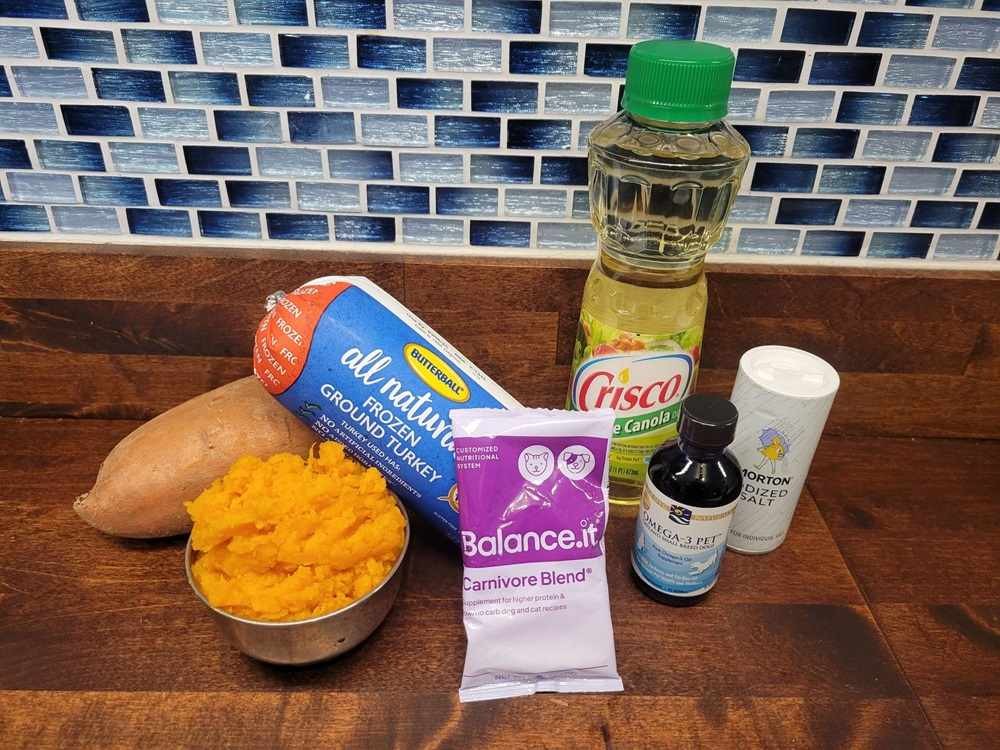
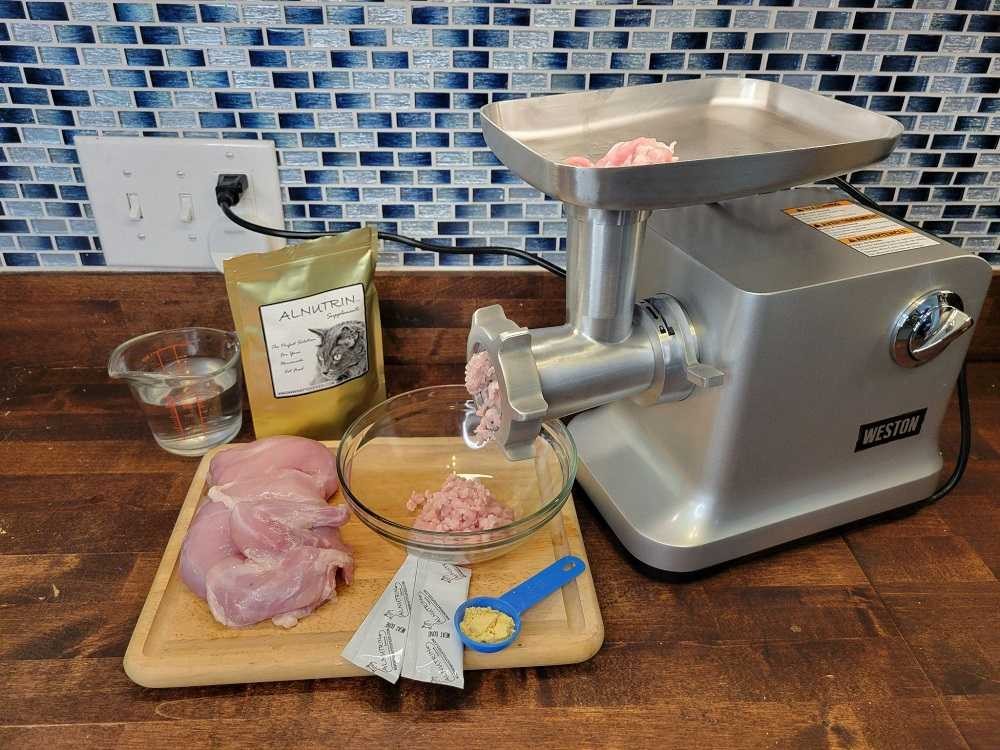
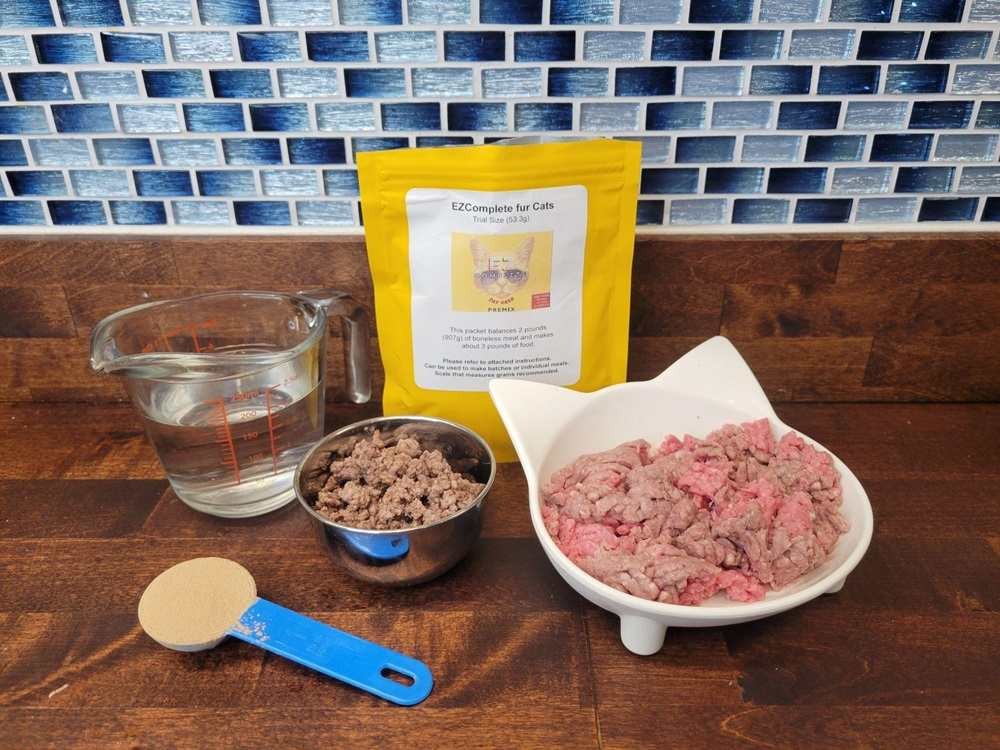
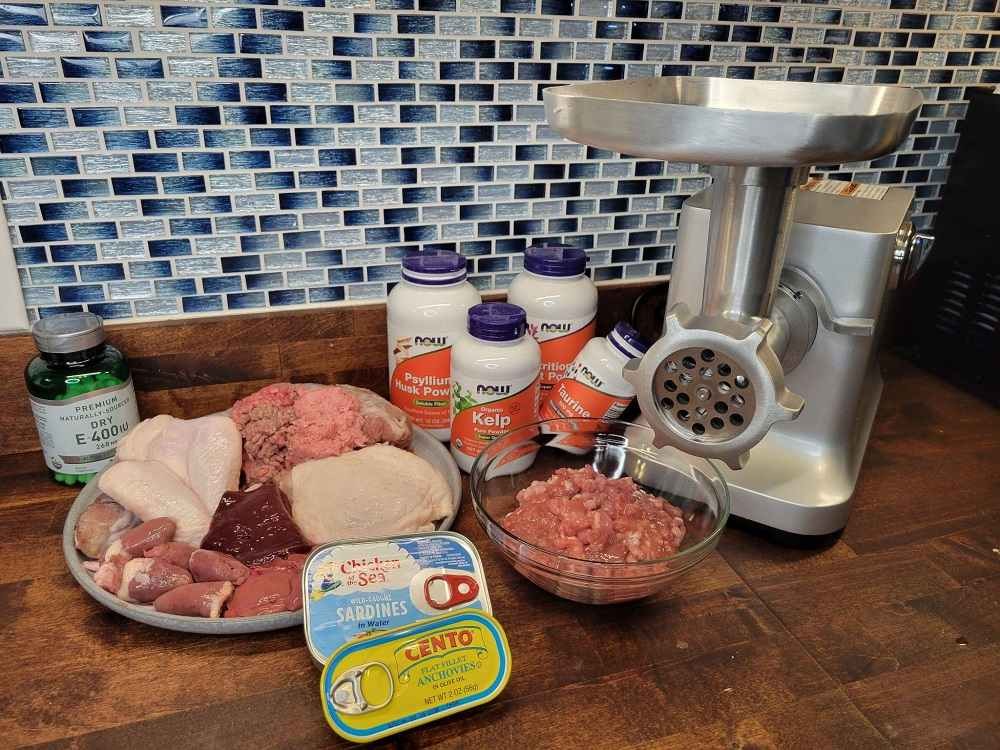
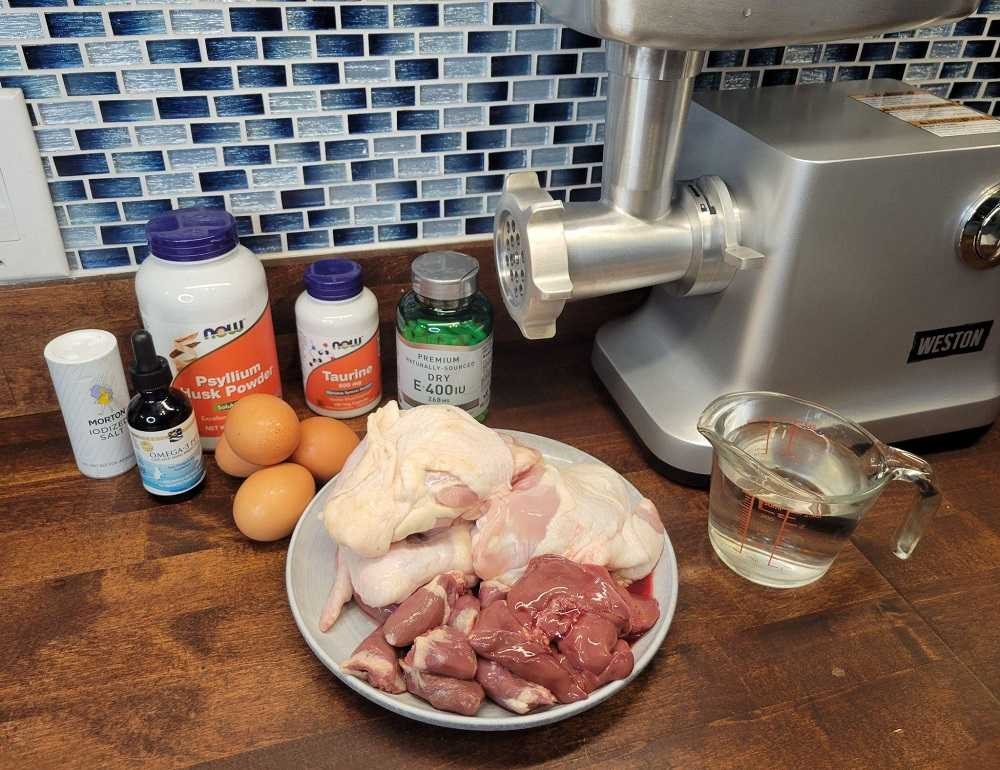
1.2 Hydration is Key
Cats don’t always have a strong drive to drink water, so hydration is really important, especially if you feed them dry food. When you make your own cat food, you can easily sneak in more moisture, which is great for their kidneys and overall health.
2. Why Consider Homemade Cat Food?
Choosing to make your own cat food comes with several potential advantages:
- Control Over Ingredients: You have complete control over the ingredients, ensuring your cat receives high-quality, whole foods without artificial additives or fillers.
- Addressing Allergies and Sensitivities: Homemade diets are excellent for cats with allergies or food sensitivities, allowing you to eliminate potential triggers.
- Enhanced Palatability: Many cats find homemade food more palatable than commercial options, making it a great choice for picky eaters.
- Promoting Overall Health: A well-balanced homemade diet can improve your cat’s digestion, coat quality, and energy levels.
2.1 Potential Drawbacks
While the benefits are appealing, it’s crucial to be aware of the potential challenges:
- Time Commitment: Preparing homemade cat food requires a significant time investment for planning, shopping, and cooking.
- Nutritional Balance: Ensuring your cat receives all the necessary nutrients can be complex, requiring careful planning and supplementation.
- Cost: High-quality ingredients and supplements can make homemade diets more expensive than commercial options.
- Risk of Imbalance: Without proper knowledge and guidance, you risk creating a diet that lacks essential nutrients or contains harmful excesses.
3. Consulting with Your Veterinarian
Before switching your cat to a homemade diet, consult with your veterinarian or a board-certified veterinary nutritionist. They can assess your cat’s specific needs, provide guidance on recipe formulation, and monitor their health during the transition. Your vet can help you create a safe and effective plan tailored to your cat’s individual needs.
4. Key Considerations for Homemade Cat Food Recipes
When creating cat food recipes, keep these essential factors in mind:
4.1 Protein Sources
Choose high-quality animal protein sources such as:
- Chicken
- Turkey
- Fish (salmon, tuna, cod)
- Rabbit
- Lean beef
4.2 Carbohydrates
While cats don’t require a high carbohydrate intake, small amounts of cooked, easily digestible carbohydrates can provide energy and fiber:
- Sweet potato
- Pumpkin
- Cooked rice
4.3 Fats
Healthy fats are crucial for energy, skin and coat health, and nutrient absorption. Include sources like:
- Fish oil
- Flaxseed oil
- Poultry fat
4.4 Essential Supplements
Unless your recipe is precisely formulated with a wide variety of ingredients, supplementation is typically necessary to meet your cat’s nutritional needs. Essential supplements include:
- Taurine
- Vitamin B complex
- Vitamin E
- Iodized salt
- Calcium
4.5 Recipe Guidelines
Here are some general guidelines to follow when creating homemade cat food recipes:
- Aim for a protein content of at least 50% on a dry matter basis.
- Limit carbohydrate content to 10-15% on a dry matter basis.
- Include healthy fats to provide at least 20% of the diet’s calories.
- Use a variety of ingredients to ensure a broad spectrum of nutrients.
- Cook all meats thoroughly to eliminate the risk of bacterial contamination.
- Avoid toxic ingredients such as onions, garlic, chocolate, and grapes.
5. Featured Cat Food Recipes
Note: The following recipes are intended as examples and should be reviewed by your veterinarian or a veterinary nutritionist before feeding to your cat. These recipes are not intended to be the basis for a complete diet.
5.1 Turkey and Sweet Potato Recipe (using Balance It® Carnivore Blend® premix)
This recipe, adapted from Balance.it, combines lean turkey with nutritious sweet potato and a comprehensive premix supplement. Balance.it is a company founded by Dr. Sean Delaney, BS, DVM, MS, DACVIM (Nutrition), a board-certified veterinary nutritionist. It is essentially an online service that builds custom pet food recipes using the brand’s assortment of premix powders.
Ingredients:
- 3 ⅜ oz. (96g) Cooked turkey breast, meat only
- 1 ⅝ tsp (7g) Canola oil
- ⅖ ml (0.37g) Nordic Naturals Omega-3 Pet Liquid
- 5/16 cup (63g) Baked sweet potato
- ⅛ tsp (0.75g) Morton Iodized Salt
- ¾ tsp (3.07g) Balance IT Carnivore Blend
Instructions:
- Roast the turkey breast at 350℉ until it reaches an internal temperature of 165℉.
- Bake the sweet potato with the turkey until the flesh is tender.
- Scoop the flesh from the sweet potato out of the skin and weigh out the desired portion.
- Finely chop the turkey breast then weigh out the amount needed.
- Combine the sweet potato and turkey in a mixing bowl.
- Add the supplements and stir well to combine.
- Divide into the desired number of meals, feeding one immediately.
- Store the leftovers in an airtight container in the refrigerator.
Nutrient Content:
- Protein: 113.43g
- Fat: 36.79g
- Fiber: 7.78g
- Ash: 7.58g
- Carbs: 48.84g
Caloric Distribution
- Protein: 47.73%
- Fat: 32.59%
- Carbs: 19.68%
- Moisture: 66.04%
Notes: If you want to prepare multiple meals at once, you can prepare extra turkey and sweet potato. Weigh out the proper portions and combine them in airtight containers. Add the supplements just before feeding. Freeze any extra you won’t use in 3-4 days.
5.2 Raw Ground Rabbit Recipe (using Alnutrin for Meat & Bone)
This recipe, using Alnutrin’s Meat & Bone premix, is designed for cats with food allergies. The premix is specifically designed to be used with whole rabbit or chicken (with bone and organs). Alnutrin premix supplements are made by Alternative Nutrition, LLC. The company was founded in 2008 by Marta Kaspar and is based in the United States.
Ingredients:
- 1 pack (4g) Alnutrin for Meat & Bone
- ¼ cup (60g) water
- 1 lbs (454g) ground raw rabbit meat & bones
Instructions:
- Cut the meat off the rabbit carcass and chop it into 1-inch pieces.
- Chop or crush the bones into pieces small enough to feed through your meat grinder.
- Grind the meat, bones, and organs into a bowl.
- In a small bowl, whisk together the Alnutrin and water.
- Stir the mixture into the ground rabbit then divide into portions and freeze.
Nutrient Content (Dry Matter)
- Protein: 65.3%
- Fat: 15.7%
- Fiber: NA
- Ash: 3.44%
- Carbs: 0%
Nutrient Analysis (As Fed, per 100g)
- Protein: 13.5g
- Fat: 3.24g
- Fiber: 0g
- Ash: 0.71g
- Moisture:3g
Notes: This premix is designed to be used with a combination of meat, organs, and bone. If you’re using whole rabbit, check to be sure it includes the organs. If not, you may need to source them elsewhere or use a different premix. The nutrient analyses above are taken from Alnutrin’s nutrient analysis using a whole dressed rabbit carcass.
5.3 Cooked Meat Recipe (using EZComplete Fur Cats)
This recipe from Food Fur Life utilizes their EZComplete Premix, made with human-grade ingredients in an FDA registered facility. It requires nothing more than boneless meat and water. Food Fur Life recommends using lean proteins like turkey breast, chicken thigh, or pork loin with EZComplete Fur Cats.
Ingredients:
- 2 lbs. (907g) ground meat, cooked
- ½ cup (53.3g) EZComplete Fur Cats
- 1 ½ cups (12 oz.) water
Instructions:
- Place the ground meat in a slow cooker.
- Add ¼ cup of water per pound of meat then cover the cooker with the lid.
- Cook on low heat for 4-6 hours until the meat is cooked through.
- Let the meat cool then shred or finely chop it into bite-sized pieces.
- Stir in the EZComplete until it is thoroughly mixed in.
- Divide the mixture into individual portions—try to divide the cooking juices as evenly as possible.
- Refrigerate or freeze the portions in airtight containers and feed as desired.
Nutrient Content (Dry Matter)
- Protein: 85%
- Fat: 11%
- Fiber: 0%
- Ash: 4%
- Carbs: 0%
Notes: The nutritional values above are taken from Food Fur Life’s nutrient analysis using EZComplete with turkey breast.
5.4 Prey Model Raw Diet Recipe (from Little Carnivore)
The Prey Model Raw (PMR) diet is a popular method for formulating homemade raw cat food. This recipe follows the PMR ratios but includes supplements to fill in any remaining nutritional gaps. This recipe follows the guidelines set forth by Coline Doebelin, a feline nutritionist and creator of The Little Carnivore raw feeding website.
Ingredients:
- 220g white meat (e.g. chicken, turkey, rabbit)
- 220g red meat (e.g. beef, lamb, duck, veal)
- 100g chicken hearts (or other heart)
- 100g gizzards, tongue, or lung
- 100g chicken, duck, or turkey neck
- 100g chicken wings or quail bones
- 15g chicken livers
- 15g beef livers
- 70g other organs (e.g. kidney, spleen, brain)
- 30g whole sardines in water
- 30g anchovies
Supplements:
- Chelated manganese
- Kelp powder (iodine)
- Psyllium husk (fiber)
- Vitamin E
- B-complex vitamins
- Calcium (optional)
- Zinc (optional)
- Taurine (optional)
- Iron (optional)
Instructions:
- Chop the ingredients into 1-inch pieces and crush the bones, if needed, to feed them through your meat grinder.
- Grind the ingredients together in the appropriate ratio OR grind all ingredients separately and weigh out the appropriate amount.
- To determine feeding amount and supplement dosages, use The Little Carnivore calculator and your cat’s body weight.
- Divide the ground mixture into the appropriate portions and freeze in airtight containers.
- At mealtime, measure out the recommended supplements and mix with the thawed food just before serving.
Nutrient Content (Dry Matter)
- Protein: 57.09%
- Fat: 30.3%
- Fiber: 0%
- Ash: 4.44%
- Carbs: 0.62%
Note: Nutrient content varies depending on the ingredients you use. This is an estimate using primarily chicken, turkey, and beef ingredients.
Nutrient Analysis (As Fed, per 100g)
- Protein: 11.3g
- Fat: 6.2g
- Fiber: 0g
- Ash: 0.88g
- Carbs: 0.12g
Notes: There are many ways to create a recipe using PMR ratios—this recipe is just what I came up with using ingredients I had on hand or could easily access. If you want to try it yourself, I recommend thoroughly reviewing the guidelines on The Little Carnivore and working with your vet (or a veterinary nutritionist) to tailor the recipe to your cat’s needs.
5.5 Ground Chicken Thigh with Bone and Organs Recipe (from Feline Nutrition Foundation)
This recipe, created by the Feline Nutrition Foundation, is commonly recommended by raw diet supporters and even raw diet brands like Hare Today.
Ingredients:
- 5 lbs. (2.27kg) chicken thighs with skin and bone
- 7 oz (200g) raw chicken liver
- 14 oz (400g) raw chicken heart
- 8 oz. water
- 4 raw egg yolks
- 2000 mg taurine
- 4000 mg wild salmon oil capsules
- 200 mg Vitamin B Complex
- 200 IU Vitamin E
- 1 ½ tsp (8.4g) Lite Iodized Salt
- 4 tsp (8g) psyllium husk powder
Instructions:
- Remove the skin from half the chicken thighs and the bone from 20-25% of them.
- Weigh out 4.5 pounds from the remaining chicken and rinse it well.
- Cut the chicken meat and organs into 1-inch pieces and crush the bones as much as you can.
- Feed these ingredients through your meat grinder along with the salmon oil capsules.
- In a small bowl, whisk the egg yolk together with the other supplements.
- Pour the slurry over the ground ingredients and mix well.
- Portion the mixture into smaller containers and freeze.
Nutrient Content (Dry Matter)
- Protein: 53.53%
- Fat: 33.06%
- Fiber: 0.81%
- Ash: 2.75%
- Carbs: 1.96%
Nutrient Analysis (As Fed, per 100g)
- Protein: 10.3g
- Fat: 6.36g
- Fiber: 0g
- Ash: 0.53g
Notes: The creator of this recipe recommends using wild salmon oil or small fish oil in capsule form because it doesn’t go bad as quickly as liquid. Do not use cod liver oil—it’s too high in vitamin A for cats. For the other supplements, by dry powder in capsules (or loose powder).
6. Essential Supplies for Making Homemade Cat Food
To streamline your homemade cat food preparation, consider investing in these essential supplies:
- Meat Grinder: A high-quality meat grinder is essential for preparing raw diets with bone and organs.
- Food Processor: A food processor can help you chop vegetables and mix ingredients thoroughly.
- Kitchen Scale: A precise kitchen scale is necessary for accurately measuring ingredients.
- Measuring Cups and Spoons: Use a set of measuring cups and spoons for precise portioning.
- Storage Containers: Invest in airtight containers for storing and freezing homemade cat food.
7. Recommended Products for Homemade Cat Food
We recommend a homemade diet consisting of ground meat (or ground meat and bone) and a premix supplement tailored to your cat’s nutritional needs. Here’s a preview of some of our top recommendations for these products, including the meat grinder I used to test the recipes.
| Product | Description |
|---|---|
| Weston Butcher Series Electric Meat Grinder Commercial Grade 1HP Motor | Powerful motor, economically priced, countertop-friendly size. |
| Balance It Feline | Formulated by a veterinary nutritionist, multiple formulas for different life stages. |
| EZComplete fur Cats | Formulated to meet AAFCO guidelines, made in the USA, just add boneless meat and water. |
| Alnutrin for Meat & Bone | Formulated to meet AAFCO guidelines, several products including one for diets containing meat, bone, and liver, free recipes available. |
| TCfeline | Formulated to meet AAFCO guidelines, made in the USA, special formula available with low phosphorus for kidney concerns. |
| Raw Meow Mix | Formulated to meet AAFCO nutrient profile minimums, made in Australia, broad line of options. |
| Purrform | Available in the UK and Europe, likely formulated according to FEDIAF nutritional standards, just add boneless meat. |
8. Safe Food Handling Practices
When preparing homemade cat food, always follow safe food handling practices to prevent bacterial contamination:
- Wash your hands thoroughly before and after handling raw meat.
- Use separate cutting boards and utensils for raw meat and other ingredients.
- Cook all meats to a safe internal temperature to kill harmful bacteria.
- Refrigerate or freeze homemade cat food promptly after preparation.
- Clean and disinfect all surfaces and equipment that come into contact with raw meat.
9. Transitioning Your Cat to Homemade Food
Introduce homemade cat food gradually to avoid digestive upset:
- Start by mixing a small amount of homemade food with your cat’s current diet.
- Increase the proportion of homemade food over 7-10 days, gradually decreasing the amount of commercial food.
- Monitor your cat’s stool and appetite during the transition.
- If your cat experiences any digestive issues, slow down the transition or consult your veterinarian.
10. Monitoring Your Cat’s Health
Regularly monitor your cat’s health and appearance while feeding a homemade diet:
- Check their coat for shine and texture.
- Observe their energy levels and activity.
- Monitor their weight and body condition.
- Assess their stool for consistency and frequency.
- Schedule regular veterinary checkups to assess overall health and nutritional status.
11. Updating Recipes Based on New Research
Nutrition is always changing, and new research can change what we know about the best diet for your cat. Keep up with the latest discoveries and advice from vets to make sure your cat’s getting the best food possible.
| Topic | New Finding | Impact on Cat Food Recipes |
|---|---|---|
| Protein Sources | Novel proteins (like insect protein) are sustainable and well-tolerated by cats. | Incorporate insect protein as a primary or supplementary protein source. |
| Carbohydrate Needs | Minimal carbohydrates are necessary, but specific fibers can aid digestion and gut health. | Focus on easily digestible fibers like psyllium husk or pumpkin in small amounts. |
| Fat Composition | Omega-3 fatty acids are crucial for reducing inflammation and supporting cognitive function. | Ensure adequate omega-3 sources, such as fish oil or flaxseed oil, with a balanced omega-6 to omega-3 ratio. |
| Supplementation | Certain prebiotics and probiotics can improve gut microbiome diversity and overall health. | Consider adding cat-specific prebiotics and probiotics to support digestive health. |
| Raw vs. Cooked Diets | The method of food preparation can affect nutrient bioavailability and digestibility. | Adjust recipes based on whether the diet is raw or cooked, ensuring nutrient retention or appropriate supplementation. |
| Life Stage Requirements | Nutritional needs vary significantly between kittens, adults, and seniors. | Modify recipes to meet the specific caloric, protein, and micronutrient requirements for each life stage. |
| Health Condition Specifics | Cats with certain health issues (e.g., kidney disease, diabetes) require tailored diets. | Customize recipes to manage phosphorus levels, carbohydrate content, or other specific dietary needs. |
| Ingredient Sourcing | The source and quality of ingredients impact the nutritional value and safety of the diet. | Prioritize high-quality, human-grade ingredients from trusted suppliers. |
| Toxin Awareness | Awareness of potential toxins and contaminants in food is increasing. | Avoid ingredients known to be harmful or contaminated, such as certain types of fish high in mercury. |
| Hydration Strategies | Maintaining adequate hydration is vital, especially for cats prone to urinary issues. | Incorporate moisture-rich ingredients and ensure fresh water is always available. |
12. Frequently Asked Questions
12.1 Is homemade cat food safe?
When properly prepared and stored, homemade cat food is safe. Take certain precautions to keep you and your cat safe. For example, take these precautions when working with raw meat:
- Clean and disinfect all surfaces and cooking tools that came into contact with the raw meat
- Wash your hands thoroughly after preparing a meal with raw meat
- Do not allow your cat to lick your face after he’s finished his meal
- If you have children, ensure that they do not touch the raw meat or allow the cat to lick their faces after the cat finishes his meal
12.2 How much does homemade cat food cost?
The cost of homemade cat food varies significantly depending on the ingredients you choose and the amount you feed your cat. Pricing will also vary depending whether you chose a cooked or raw homemade diet.
12.3 Is raw cat food better than cooked?
Raw cat food is generally regarded as the most biologically appropriate diet for cats by animal nutritionists, but it isn’t the right choice for every cat owner. Also, raw meats can contain bacteria, such as E. coli, that cause foodborne diseases. Do some research to compare the different options and decide which works best for your cat.
12.4 How much should I feed my cat?
The average adult cat needs about 200 calories per day, or about 6 ounces of homemade food. The calorie content of the food will vary, of course, depending on the proteins and fats you use. Talk to your veterinarian and consult online calorie calculators to determine your cat’s specific calorie requirements and go from there.
12.5 Can I make homemade cat food in bulk?
Yes, homemade cat food can be made in bulk and stored in the freezer for future use. However, it is important to ensure that the food is properly portioned and stored in airtight containers to maintain its quality and prevent freezer burn.
12.6 How do I know if my cat is getting enough taurine?
Taurine is an essential amino acid for cats, and a deficiency can lead to serious health problems. Ensure that your homemade cat food recipe includes taurine-rich ingredients such as meat, especially heart and liver.
12.7 What are the signs of a food allergy in cats?
Signs of a food allergy in cats can include skin irritation, itching, hair loss, digestive upset (vomiting or diarrhea), and respiratory issues. If you suspect your cat has a food allergy, consult with your veterinarian.
12.8 Can I use human supplements in homemade cat food?
While some human supplements are safe for cats, it is important to consult with your veterinarian before adding any supplements to your homemade cat food recipe.
12.9 How do I switch my cat to homemade cat food?
Switching your cat to homemade cat food should be done gradually to avoid digestive upset. Start by mixing a small amount of homemade food with your cat’s current diet and gradually increase the proportion of homemade food over 7-10 days.
12.10 What if my cat refuses to eat homemade cat food?
If your cat refuses to eat homemade cat food, try mixing it with a small amount of their favorite commercial food or adding a flavorful ingredient such as tuna juice or chicken broth.
Conclusion
Creating homemade cat food recipes can be a rewarding experience, offering greater control over your feline friend’s diet and promoting their overall health. By understanding the essential nutrients, following safe food handling practices, and consulting with your veterinarian, you can create delicious and nutritious meals that your cat will love.
Ready to take your cat’s diet to the next level? Explore more expert advice and innovative recipes at foods.edu.vn. Visit us at 1946 Campus Dr, Hyde Park, NY 12538, United States, or reach out via Whatsapp at +1 845-452-9600. Begin your journey towards healthier, happier mealtimes today!
